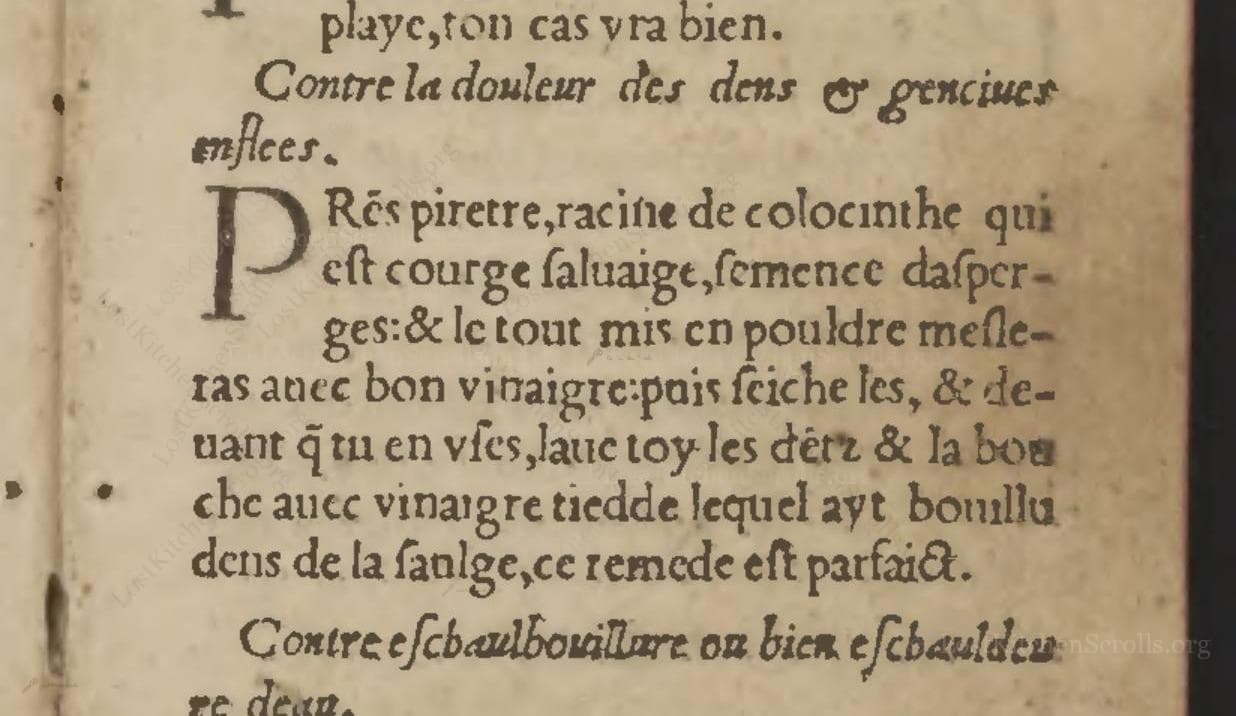Contre La Douleur Des Dens & Gencives Enflees
"Against Toothache And Swollen Gums"
From the treasured pages of Bastiment de receptes
Unknown Author

Contre La Douleur Des Dens & Gencives Enflees
"P Rēs piretre, racine de colocinthe qui est courge saluaige, semence dasperges: & le tout mis en pouldre mesleras auec bon vinaigre: puis seiche les, & deuant q tu en vses, laue toy les dẽz & la bouche auec vinaigre tiedde lequel ayt boullu dens de la saulge, ce remede est parfaict."
English Translation
"Take equal parts of pellitory, root of colocynth (which is wild gourd), asparagus seed: and mix them all in powder with good vinegar. Then dry them, and before you use it, wash your teeth and mouth with warm vinegar, in which some sage has been boiled. This remedy is perfect."
Note on the Original Text
Early modern recipes like this one were composed in vernacular French, often translated from Italian, with spelling and grammar reflecting regional and era-specific conventions—note, for example, 'dens' for 'dents' (teeth), and 'saulge' for 'sage'. Quantities, when given, were vague, presuming the cook or apothecary's knowledge. Instructions focused on process instead of precise measurement, reflecting an experiential, hands-on approach to creating both food and medicine.

Title
Bastiment de receptes (1541)
You can also click the book image above to peruse the original tome
Writer
Unknown
Era
1541
Publisher
A Lescu de Coloigne
Background
Step into the culinary secrets of Renaissance France! 'Bastiment de receptes' is a delectable compendium newly translated from Italian, brimming with recipes, curious odors, and medicinal tidbits designed to both delight the palate and preserve health.
Kindly made available by
Library of Congress
This recipe hails from 'Bastiment de receptes', a 1541 French compilation of translations from Italian recipe and remedy books. Published in Lyon by Jean and François Frellon, this collection was intended to preserve and share knowledge regarding perfumes, household substances, and practical medical remedies. At a time when dental care was rudimentary and access to professional medicine limited, such household remedies offered relief from common ailments like toothaches and swollen gums using the knowledge passed down through herbal traditions.

In the 16th century, preparing this remedy required basic household tools: a mortar and pestle for grinding roots and seeds into powder, a fine sieve for sifting the powder, ceramic or glass mixing bowls for combining with vinegar, and a small pot to heat and infuse vinegar with sage. The finished mixture would likely be stored in small ceramic jars. The medicine would be applied with a clean fingertip, a piece of cloth, or a small spatula.
Prep Time
15 mins
Cook Time
10 mins
Servings
15
We've done our best to adapt this historical recipe for modern kitchens, but some details may still need refinement. We warmly welcome feedback from fellow cooks and culinary historians — your insights support the entire community!
Ingredients
- 0.18 oz dried pellitory root (Anacyclus pyrethrum), powdered
- 0.18 oz colocynth root (substitute: 0.07 oz pumpkin seed powder or omit)
- 0.18 oz asparagus seed, powdered
- 1 fl oz red wine vinegar
- 3.4 fl oz red wine vinegar (for rinse)
- 0.35 oz fresh sage leaves (for infusion)
Instructions
- To prepare this historic remedy for tooth and gum pain, take equal amounts (for example, 0.18 ounces each) of pellitory root (Anacyclus pyrethrum), colocynth root (Citrullus colocynthis, which is a wild gourd—now toxic, so substitute with a small amount of pumpkin seed powder or leave out), and asparagus seed.
- Grind these ingredients into a fine powder using a mortar and pestle.
- Mix the resulting powder thoroughly with about 2 tablespoons (1 fluid ounce) of good-quality vinegar—preferably red wine vinegar—to form a thick paste.
- Let the mixture dry completely, then store it in an airtight container.
- Before using, gently rinse your mouth and teeth with a warm sage-infused vinegar (to make: bring 3.4 fluid ounces vinegar to a boil, add a handful of fresh sage leaves, let it cool to warm).
- After rinsing, apply a small amount of the dried powder mixture to the affected area.
Estimated Calories
2 per serving
Cooking Estimates
Preparing this historic tooth and gum remedy takes about 15 minutes to gather and grind the herbs, mix with vinegar, and let it dry. Making the sage rinse will take another 10 minutes. Each use is a very small dose, so the calories per serving are very low. The total recipe yields about 15 applications.
As noted above, we have made our best effort to translate and adapt this historical recipe for modern kitchens, taking into account ingredients nowadays, cooking techniques, measurements, and so on. However, historical recipes often contain assumptions that require interpretation.
We'd love for anyone to help improve these adaptations. Community contributions are highly welcome. If you have suggestions, corrections, or cooking tips based on your experience with this recipe, please share them below.
Join the Discussion
Rate This Recipe
Dietary Preference
Main Ingredients
Occasions

Den Bockfisch In Einer Fleisch Suppen Zu Kochen
This recipe hails from a German manuscript cookbook compiled in 1696, a time whe...

Die Grieß Nudlen Zumachen
This recipe comes from a rather mysterious manuscript cookbook, penned anonymous...

Ein Boudain
This recipe comes from an anonymous German-language manuscript cookbook from 169...

Ein Gesaltzen Citroni
This recipe, dating from 1696, comes from an extensive anonymous German cookbook...
Browse our complete collection of time-honored recipes



